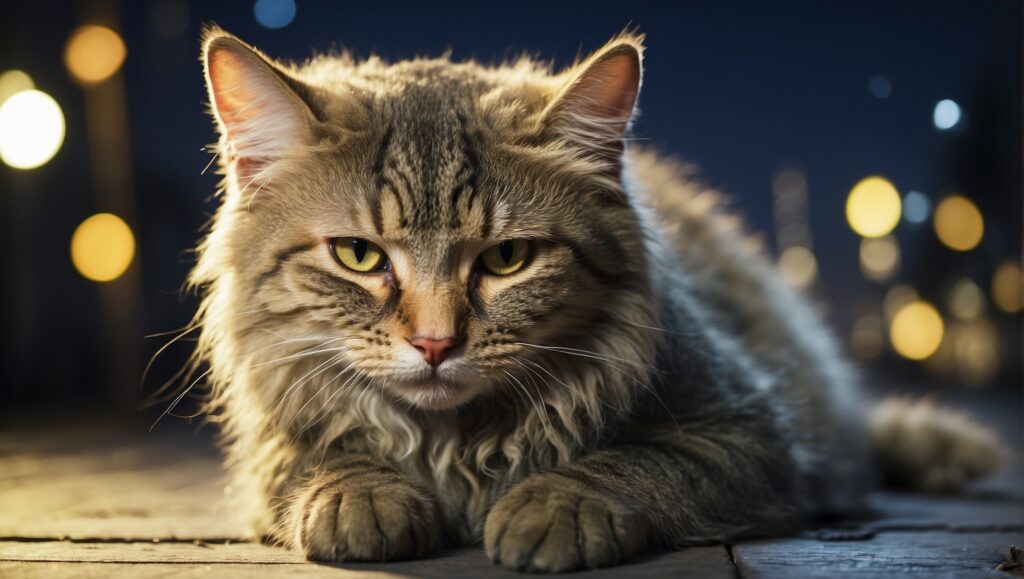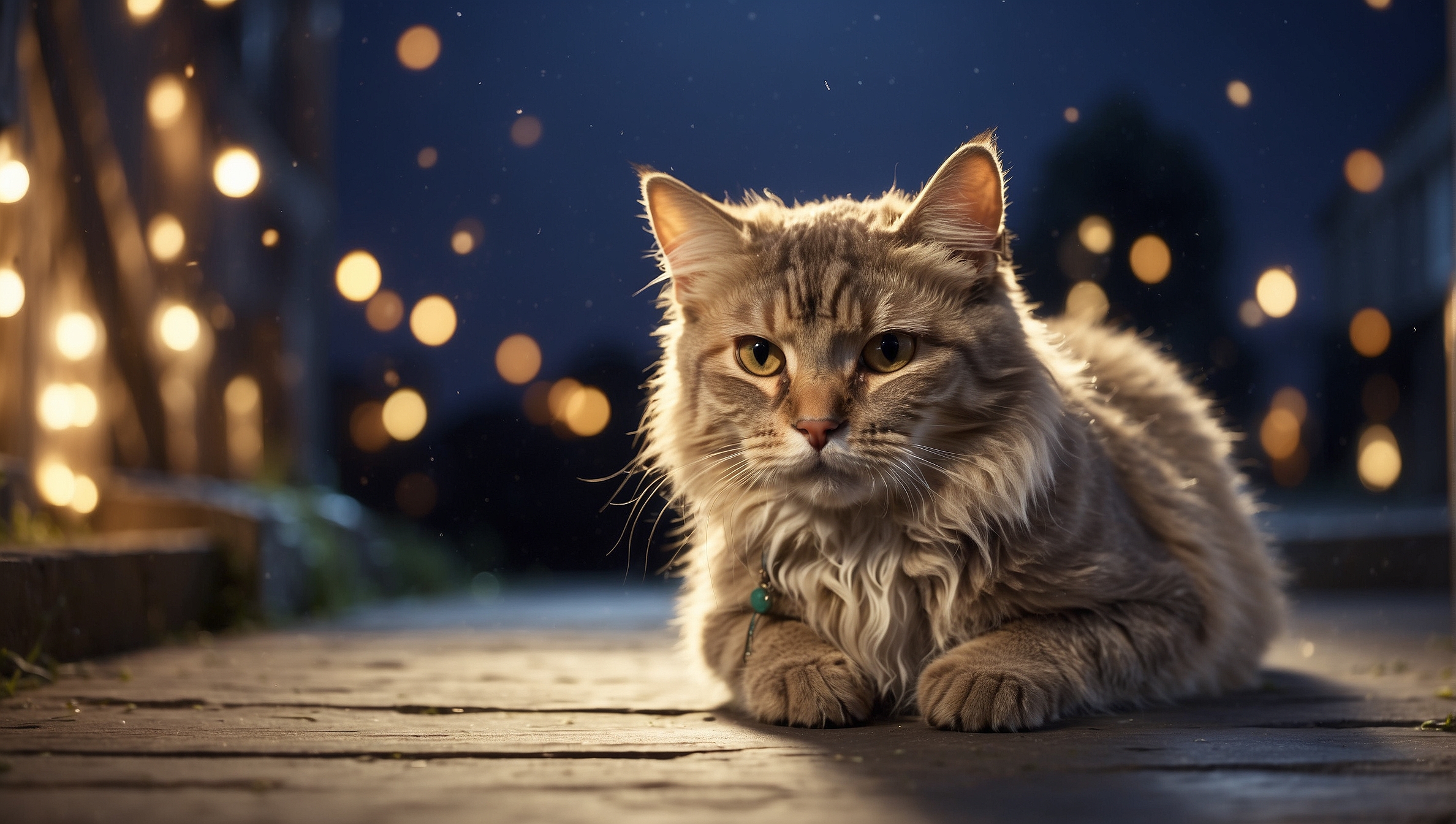Have you ever wondered why your cat decides to run around the house at 2am, knocking over objects in the process? While it may seem like an unwarranted disturbance to your sleep, it’s actually quite normal and stems from your cat’s natural instincts and sleep-wake cycles.
Understanding feline behavior patterns and their night vision can help us better manage our furry friends and coexist harmoniously. In this article, we will explore why cats are more active at night, their sleep-wake cycles, and the behavior patterns they exhibit at nighttime.
Key Takeaways
- Cats are naturally more active at night due to their feline instincts and sleep-wake cycles.
- Cat sleep-wake cycles are different from humans and influence their activity levels.
- Cats have exceptional night vision, making them effective hunters in the dark.
- Behavior patterns such as prowling and vocalization are common in cats at night.
- Managing nocturnal cat behavior and optimizing their sleep environment can improve daytime rest.
Cat Sleep-Wake Cycles: Understanding the Nighttime Activity
Have you ever wondered why your cat seems to be full of energy and mischief during the night while sleeping through most of the day? Understanding cat sleep-wake cycles can help us unravel this nocturnal behavior.
Cats are naturally crepuscular animals, which means they are most active during dawn and dusk. However, domesticated cats’ behavior can be influenced by their owners’ schedules, resulting in them adapting to a more nocturnal lifestyle.
Just like humans, cats have a circadian rhythm that regulates their sleep and activity levels. Curiously, cats spend most of their day sleeping, averaging between 12 to 16 hours a day. This prolonged sleep time is due to their evolutionary history as predators, where they would conserve energy during the daytime to hunt during the night.
During their periods of wakefulness, cats engage in various activities like grooming, play, socialization, and hunting. However, their activity patterns can vary depending on their environment and individual preferences. Some cats might be more active during the night, while others might enjoy playtime during the day.
Cat Sleep-Wake Cycles
| Stage | Description | Duration |
|---|---|---|
| Awake | Cat is alert and active | N/A |
| Drowsy | Cat is relaxed but still awake | 5-10 minutes |
| Light Sleep | Cat’s muscles start to relax, and breathing becomes more regular | 30 minutes |
| Deep Sleep | Cat is in a deep sleep state, and muscles are entirely relaxed | 6-30 minutes |
| REM Sleep | Cat is in a dreaming state, and muscles are temporarily paralyzed | 5-10 minutes |
Cats can transition through different sleep stages throughout the day, with a higher percentage of deep sleep during the daytime. However, during the night, cats are likely to activate their hunting instincts during their wakeful periods.
Understanding and Managing Cat Activity Levels
It’s essential to consider your cat’s sleep-wake cycle when understanding and managing their behavior patterns. Providing them with an enriching environment during their wakeful periods, engaging them in playtime, and ensuring they have a designated sleeping area can help balance their activity levels.
However, suppose you notice that your cat’s nighttime activity is disruptive and unsustainable. In that case, it’s advisable to consult with a veterinarian to rule out any underlying medical issues and develop a customized behavior management plan.
Understanding your cat’s sleep-wake cycle is a crucial step in strengthening your bond with your furry friend and ensuring a harmonious relationship.

Cat Night Vision: Understanding Feline Hunting Instincts
Have you ever noticed how your cat’s eyes seem to glow in the dark? That’s because of their extraordinary night vision, which allows them to navigate and hunt in low-light conditions.
Unlike humans, cats have a larger pupil that can dilate wider to let in more light, along with a reflective layer at the back of their eyes called the tapetum lucidum. This layer bounces incoming light back through the retina, amplifying the signal and making it easier for cats to see in the dark.
This unique vision gives cats a significant advantage when hunting at night, allowing them to spot prey that would be invisible to humans or other animals. Their pupils can dilate up to six times more than the average human, and they can detect movement at a distance of up to 200 feet in complete darkness.
| Cat Night Vision vs. Human Vision | Cats | Humans |
|---|---|---|
| Field of view | 200 degrees | 180 degrees |
| Low-light vision | 6-8 times better | Limited |
| Color vision | Less vivid, can’t distinguish between red and green | Vibrant and varied |
Along with their keen sense of smell and silent movements, cat’s night vision is an essential tool to fulfill their instinctual hunting needs. Even domesticated cats retain their hunting instincts, which is why they may exhibit night-time behavior patterns such as stalking, pouncing, and playing with toys.
Understanding and appreciating the importance of cat night vision can help pet owners create a safe and happy environment for their feline companions, allowing them to indulge their natural hunting instincts while keeping them protected.
Unmasking Feline Behavior Patterns After Dark
Have you ever wondered what your furry feline friend gets up to when the lights go out? While cats are known to be crepuscular animals, meaning they are most active during dawn and dusk, many of our beloved pets are also active at night. Understanding your cat’s nighttime behavior patterns can help you develop a deeper connection with them and ensure you provide an environment that nurtures their instincts and behavior patterns.
Prowling
The nighttime is when cats become master hunters. With their enhanced night vision, felines have a competitive edge in stalking prey and hunting for food. As nocturnal animals, they are more alert and receptive to their surroundings and are likely to prowl around the house, even if it seems like they have nothing to do.
Playfulness
Just like humans, cats have different personalities and attitudes. Some felines are more playful than others and enjoy running around and engaging in various playing activities in the middle of the night. They do not differentiate between day and night, and so they tend to be active whenever they feel like playing.
Vocalization
Cats are notorious for being vocal, and they particularly enjoy expressing themselves at night. If you hear your feline friend meowing or making other noises during the night, don’t be alarmed as it’s a natural behavior for them. They may be seeking attention, expressing their dissatisfaction, or communicating with other cats outside.
Understanding your cat’s nocturnal behavior is essential in developing a deeper bond with them. While it’s impossible to change an animal’s natural instincts, you can manage their behavior and ensure they remain happy and healthy. Providing them with an appropriate environment and engaging in playtime during the day can help balance their sleep-wake cycle and energy levels.
Managing Nocturnal Cat Behavior: Tips and Tricks
While cats’ nighttime activities can be adorable, their behavior can also disrupt your sleep and lead to destructive behaviors. Here are some tips to manage your nocturnal cat’s behavior:
- Playtime: Engage your cat in interactive play sessions for at least 20 minutes before bedtime, which can help tire them out and reduce their nighttime activity levels.
- Feeding Time: Feed your cat their biggest meal of the day right before bed to encourage them to sleep through the night. Remember to portion out their meals to avoid obesity.
- Bedtime routines: Create a relaxing bedtime routine for your cat and stick to it. It can include grooming, cuddling, or just turning off the lights to signal it’s time to sleep.
- Nocturnal Distractions: Provide your cat with plenty of toys, scratchers, and perches to keep them occupied during their active hours. This can redirect their behavior and prevent them from disturbing your sleep.
- Separation: If your cat’s nocturnal activities are too disruptive, consider closing them in a separate room at night with plenty of toys, a cozy bed, and a litter box.
Remember, each cat is different, so you may need to experiment with different strategies to find the ones that work best for your feline friend. With patience and persistence, you can manage your cat’s nighttime behavior and enjoy peaceful nights together.
Optimizing Your Cat’s Sleep Environment for Daytime Rest
If you’re a cat owner, you know that your feline friend’s nocturnal behavior can sometimes disrupt your sleep patterns. But did you know that cats need up to 16 hours of sleep a day, depending on their age and activity level?
Ensuring that your cat gets enough rest during the day is key to managing their nighttime activities. Here are a few tips for optimizing your cat’s sleep environment:
- Provide a comfortable sleeping area: Cats love snuggling up in cozy, warm spots. Consider providing a soft bed or blanket in a quiet, secluded area of your home where your cat can rest undisturbed.
- Minimize disruptions: Avoid loud noises and sudden movements that may startle your cat during their daytime sleep. If you have children or other pets, make sure they know not to disturb your cat when they’re sleeping.
- Create a consistent routine: Cats thrive on routine. Try to keep your cat’s sleeping and feeding times consistent, which can help them establish a regular sleep-wake cycle.
By creating a comfortable, quiet sleep environment for your cat, you can help them get the rest they need during the day. This, in turn, can help manage their nighttime activity levels and ensure a more harmonious coexistence between you and your feline companion.
Conclusion
Now that we’ve uncovered the secrets behind cats’ nighttime behavior, we can better understand and manage their activity levels for a harmonious relationship. From their natural feline instincts and sleep-wake cycles to their exceptional night vision, cats are built for nocturnal activities. By recognizing their behavior patterns and providing an optimal sleep environment, we can ensure they receive sufficient rest to balance their nighttime activities.
The Importance of Managing Nocturnal Cat Behavior
While cats may be more active at night, excessive nighttime activities can disrupt our sleep and lead to behavioral issues. By redirecting their energy with interactive toys and providing designated play areas, we can manage their behavior and prevent destructive habits.
Understanding Feline Behavior Patterns at Night
Cats exhibit specific behavior patterns at night, such as vocalization, prowling, and playfulness, that differ from their daytime activities. By recognizing and accepting these behaviors, we can appreciate their unique personalities and strengthen our bond with them.
The Role of Night Vision in Feline Behavior
Cats’ exceptional night vision plays a significant role in their nocturnal activities, allowing them to navigate and hunt in low-light environments. By providing adequate lighting in their environment, we can enhance their safety and comfort during nighttime hours.
By incorporating these insights into our daily interactions with our feline friends, we can enjoy a happy and harmonious relationship, even when they’re more active at night.
FAQ
Why are cats more active at night?
Cats are naturally nocturnal animals, which means they are more active during the night. This behavior is influenced by their feline instincts and sleep-wake cycles.
What are cat sleep-wake cycles?
Cat sleep-wake cycles refer to the patterns of rest and activity that cats go through in a 24-hour period. These cycles, also known as circadian rhythms, make cats more active during the night.
How does a cat’s night vision contribute to their nighttime activities?
Cats have exceptional night vision, which allows them to see in low light conditions. This advantage stems from their evolutionary adaptation for hunting. Their enhanced night vision plays a significant role in their nocturnal activities.
What behavior patterns do cats exhibit at night?
Cats may exhibit various behavior patterns at night, including prowling, playfulness, and vocalization. These behaviors are part of their innate instincts and contribute to their mysterious nighttime antics.
How can I manage my cat’s nighttime behavior?
To manage your cat’s nighttime behavior, you can try redirecting their activities with interactive toys, providing a stimulating environment during the day, and establishing a consistent bedtime routine. Consulting with a veterinarian or animal behaviorist can also be helpful.
How can I optimize my cat’s sleep environment during the day?
To ensure your cat gets sufficient rest during the day, create a quiet and comfortable sleep environment. This can include providing a cozy bed, minimizing disturbances, and blocking out excessive light.


